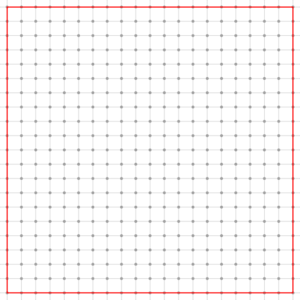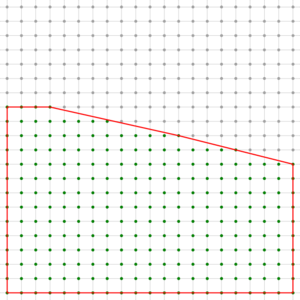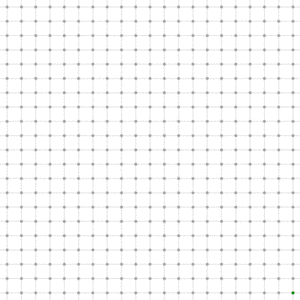- Author(s) of this documentation:
- Jacques-Olivier Lachaud
Part of the Arithmetic package.
This module gathers classes and functions to represent lattice polytopes in 2D (otherwise saide, convex polygons with vertices at integer coordinates) and digital half-spaces. The main part of the module is the class LatticePolytope2D, which represents these polytopes. This module is a possible solution for solving integer linear programming in the plane. It is thus the basis for the COBA algorithm for recognizing digital planes (see COBANaivePlaneComputer).
Creating a lattice polytope in Z2
The class LatticePolytope2D represents an arbitary convex polygon in the 2D plane whose vertices have integer coordinates. It is parameterized by a digital space TSpace (a model of CSpace with dimension 2) and by the container class TSequence for storing vertices (a model of [boost::Sequence http://www.sgi.com/tech/stl/Sequence.html] over TSpace::Point, default is std::list<TSpace::Point>). The class LatticePolytope2D contains as a data member some TSequence instance and you may use all the standard methods of sequences. All the useful data of a LatticePolytope2D are in the TSequence data member.
The class LatticePolytope2D is a model of boost::Sequence, but also of boost::DefaultConstructible, boost::CopyConstructible, boost::Assignable. This class is also a model of CDrawableWithBoard2D. You may therefore display it on a Board2D object.
Since a sequence is ordered, its order defines the order of vertices along the polygon, i.e. any vertex in the sequence forms an edge with the previous vertex and another edge with the next vertex. Note that the vertices must follow the clockwise ordering, i.e. the inside of the polygon is to the right-hand side when moving along the polygon. The following example defines a triangle in the standard limited integer planes Z2i::Z2 (integer coordinates are int32_t):
- Note
- This class contains a mutable object IntegerComputer as well as several other mutable members to perform computations efficiently (see dgtal_integer_computations). However these private data members are not copied nor assigned. They exists so as to avoid memory managements when using big integers.
You may use any insertion/deletion methods of a sequence (insert, erase, push_back, push_front, etc). Be careful however, in order that the object has a correct behaviour in more elaborate methods like LatticePolytope2D::cut() or LatticePolytope2D::findCut, you must enforce that inserted or deleted vertices leave the polytope convex.
Displaying 2D lattice polytopes
A LatticePolytope2D is a model of CDrawableWithBoard2D. Therefore it is displayable on a Board2D with the operator <<. The following example displays a square in red over its domain.
You may choose colors with the usual CustomStyle / CustomColors mechanism. Furthermore, choosing Color::None for filling colors allows to draw only the boundary of the polygon.

Converting a 2D lattice polytope into a digital set
It is sometimes useful to enumerate all the integer points lying within the polygon bounds. The method LatticePolytope2D::getIncludedDigitalPoints() is templated by the type TDigitalSet, which must be a model of CDigitalSet. It modifies the digital set given in parameter so as to holds these points. For now, the complexity is not optimal. If D is the size of the domain of TDigitalSet, N the number of vertices of the polygon, then the complexity is upper bounded by O(ND log(D)) (if TDigitalSet is DigitalSetBySTLSet).
Basic services: vertices, centroid, area
Since a LatticePolytope2D is a sequence, you may iterate over the vertices with the usual LatticePolytope2D::begin()and LatticePolytope2D::end(), with two versions of iterators (Iterator and ConstIterator). To know if the polygon has no vertices, it is faster to use LatticePolytope2D::empty(). Otherwise you may obtain the following information:
- number of vertices: LatticePolytope2D::size()
- the double of the area, which is an integer: LatticePolytope2D::twiceArea()
- the exact centroid of the polygon as a triplet of integers (x,y,g), where the centroid rational coordinates are (x/g,y/g): LatticePolytope2D::centroid().
A LatticePolytope2D P may have zero area (in this case it has at most two vertices). Thanks to Pick formula, you can also get the exact number b of points on the boundary and the exact number i of points in the interior of the polygon: \( A(P) = i + b/2 - 1 \).
- number of interior points: LatticePolytope2D::numberInteriorPoints
- number of boundary points: LatticePolytope2D::numberBoundaryPoints
Polygon edges define half-planes
A lattice polytope polygon may be defined by a list of vertices (with some properties) but also as the intersection of half-planes. For instance, if \( (v_i)_{i=0..n-1} \) are the vertices of the polytope, then the polytope is also the intersection of the half-planes which contains the polytope centroid and whose boundary contains edges \((v_i,v_{i+1})\).
You may use the following methods:
- to get the half-plane defined by an edge: LatticePolytope2D::halfSpace() with an iterator on the first vertex.
- to get an arbitrary half-plane defined by three points (two on the boundary, one inside): LatticePolytope2D::halfSpace( const Point & A, const Point & B, const Point & inP ) const.
- Given some half-plane, finds the edges/vertices of this polygon that crosses/borders this half-plane: LatticePolytope2D::findCut(). Also returns the number of vertices inside the half-plane.
Cutting the polygon by half-planes
You may also update a LatticePolytope2D by intersecting it with half-planes, i.e. linear constraints of the form ax+by <= c. The polygon is updated so that all its vertices have integer coordinates and the constraints are fulfilled. This means for instance that a set of linear constraints may have a non-empty interior (in the Euclidean space sense), but the resulting polygon may be empty or have an empty interior. However, it is guaranteed that all integer solutions are kept.
This snippet is taken from example lower-integer-convex-hull.cpp. It cuts the polygon by calling LatticePolytope2D::cut. An half-plane is specified beforehands by instantiating a LatticePolytope2D::HalfSpace. Note that it is a redefinition of the class ClosedIntegerHalfPlane.

This shows the successive polygons obtained by cutting a square with constraints -5x+8y <= c.
